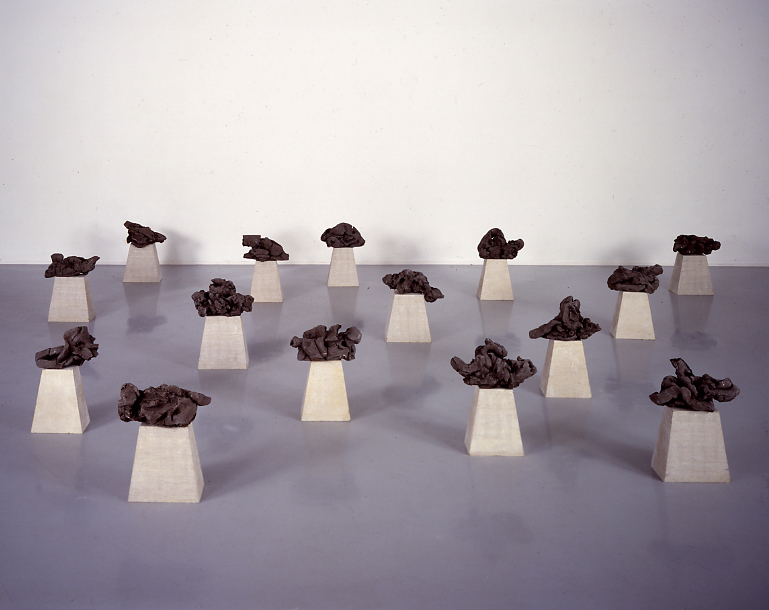A Letter to my Translator, by Barry Schwabsky Catalogue Alain Kirili, Musée d'Art Moderne de Saint Etienne, 1992
Dear Murielle,
Here is the essay you are supposed to be translating. I don't imagine you'll have much difficulty with it, but still I feel the need to explain it a bit, because that lack of difficulty for you is somewhat deceptive; I had some trouble writing it, and I want you to try and put some of that difficulty back into it when you turn it into French. You see, Kirili's work was difficult to write about because I found that, in writing about a particular piece or series of pieces, I’d only written about that one, while much that is essential to other works of his had escaped me; but then when I tried to generalize, I found that I’d failed to really explain the individual works. The problem was always that of articulating the relation of the parts to the whole, the one to the many.
And then I felt constrained by the difficulty of finding the right tone, the right angle. For example, I thought it better to avoid getting too involved in art history, tempting though that could be with an oeuvre as rich in traditions and references as that of Kirili. But I am no art historian, or (if I care to flatter myself) at best an amateur one, and as amateur art historians go, Kirili himself is a better one than I am -witness his writings on Rodin, on Medardo Rosso, on Giacometti, on Bamett Newman; he is a scholar among sculptors although his is the scholarship of an artist and not a scholar- so it seemed unlikely I’d be able to add much that a careful reading of Kirili's own texts and interviews wouldn't suggest on their own. A quick example from a publication that has just reached me, the catalogue to Le Baiser, a recent exhibition at the Villa Arson in Nice: Kirili writes of some recent works in terracotta: ''j'ai parfois percé le volume avec des plaques, des barres et des tubes en fer ... Je voulais arriver à trouver un passage entre la souffrance chrétienne et l'animisme des fétiches africains." With an artist who is at once so lucid and so forthcoming about not only his sources but also their meaning in his work, further elaboration might produce little more than cleverness.
On the other hand it seemed just as important to avoid the temptation of what is called art journalism. That is, basically, the profile of the artist, which situates the work as a by-product of the life that is held to be its cause. The biographical fallacy. We hear about the set-up of the artist's studio and his working day, perhaps his opinions on various contemporaries and precursors, his education and travels, etc. etc. This is not an approach I’d ordinarily give much thought to, since I tend to think in a fairly abstract and analytical fashion and have little talent for dramatization or the homely detail, but with Kirili it almost seems to make sense. I don't suppose you've met him, but if you have, you'll know that he is one of those rare contemporary artists who does not view art as a profession. That is, he'd rather make as little distinction as possible between his work and the rest of ms life. He wants them all to be of a piece. Not in the Beuysian sense of art as activism, as what he called "social sculpture", but in a rather more old-fashioned sense. Kirili would, I think, like his life to be in itself an image of aesthetic struggle and fulfillment, the image of a way of living centered around the devotion to art. And I've noticed how he loves meeting artists, especially older ones, artists with a certain link to tradition, and getting to know all about their ways of life, their habits and quotidian practices is his great delight. You should hear him talk about his meetings with Louise Bourgeois or Eugène Leroy. I remember once being at a party with him, when he gestured toward the other side of the room and asked me, "Who is that gentleman with the beard over there?" I told him it was Milton Resnick, and within five minutes they were deep in conversation. Suddenly Resnick was reminiscing about how, just after the war when he was living in Paris, he used to sit at a certain cafe every day, and the strange fellow who would sit just as regularly at the next table turned out to be Antonin Artaud. Alain is sure he learns from exchanges like this and probably he's right. Itmakes me realize how much art can be, as Willem de Kooning said more than forty years ago, "a way of living today, a style of living so to speak. That is where the form of it lies' -which is difficult for a writer to understand; writing seems so much more a practice of privacy, a kind of withdrawal from life. Do we imagine our word processors surrounded by the myriad inhabitants Courbet represents in his studio? I think not.
Well, obviously I haven't really been able to avoid playing the art historian or the art journalist, nor any of the other roles a writer on art finds himself having to play. The thing that I hope I have somehow escaped is for the essay to seem to have been written according to the conventions of just one of those types of art writing -whereas it moves freely among all of them; so that in finding your tone in French you must constantly allow yourself to be not simply tempted but in fact seduced by those conventions and others, as long as you thereupon allow yourself to be abandoned by them as soon as the next one presents itself.
You may wonder about my choice of form for the essay. If I have allowed myself to frame my text as a sequence of fragments, it is because I don't consider imitative form a fallacy. That is, I consider the problematic of the fragment to be absolutely central to Kirili's entire oeuvre, and I wanted to accept the challenge of this same problematic into my own writing, the better to comprehend the nature of his work. I should say straight away that my understanding of the genre of the fragment was guided by the subtle considerations on it in Philippe Lacoue-Labarthe and Jean-Luc Nancy's book on German Romanticism, The Literary Absolute; and as a translator you may be charmed to hear that I read this book through a translation partly by Philip Barnard, who happens to be both a friend of Kirili's and the translator into English of many of his writings. Kirili tells me he has not read the book, but no matter; it's clear enough that the book is pursuing him.
For me, Kirili's key works must be the remarkable series of Commandments, along with a number of related sculptural groups such as the ones shown at the Villa Arson, Venise and La Vague,together comprising Le Baiser. These show most clearly what I mean by the problematics of the fragment. In Commandment XV; for instance, which I recently had the chance to spend some time with at the Brooklyn Museum, the iron "characters" sitting on their squat pedestals present (as the elements in all the series of Commandments do) the aspect of an alphabet, a set of primal glyphs. And as an arrangement, when one looks down on them, they appear as a kind of landscape: a terrain of inscription or perhaps, in Baudelaire's phrase, a forest of symbols. But beyond that, the rough edges of these planar figures proclaim that they are the product of a sequence of breakages, that they are remainders of a sort. These breaks are constitutive of something; as Lacoue-Labarthe and Nancy write, "lf the fragment is indeed a fraction, it emphasizes neither first nor foremost the fracture that produces it. At the very least, it designates the borders of the fracture as an autonomous form as much as the formlessness or deformity of the tearing." As I point out, this sense of dialectical interplay -between fragmentary self-definition and its implication of a larger system which never appears unless through that very autonomy of its parts- also shows itself in the apparent eclecticism of Kirili's work. Look at the multiplicity of it: the totemic assertions of forged iron, the lyrical self- involvement of the smaller plasters which are so rightly given names like Ivresse or (when penetrated by iron wire) Noces, the towering ascension given by the synthesis of these in a work like the Grande Nudité, the fragility exploding upward in Oratorio and other works in forged aluminum, more recently the works in which cement is both modeled and carved to give new tension to the struggle for the image.
And then of course there are the table pieces, groupings of objects in diverse materials on a common base, which dissimulate the strangeness of their juxtapositions by the "user-friendly" to- handness implied by the genre of the still life to which they evidently refer. What sculptor has shared himself out among so many distinct modes? Yet as clear as it is that in so doing Kirili has always tried to listen to the demands of his materials without imposing a single "style" on all his work, it is even clearer that we are very far here from any mere eclecticism. That is why the
Commandments are so important in my eyes; each set being all of a piece, as it were, they make it clear that the issues of style and of materials are only secondary to this problem of the fragment, of the multiplicity that implies the possibility of a totality, a problem that I’d like to say would remain even in the absence of Kirili's incredible diversity, were it not that this sense of a potential system must be precisely that diversity's cause. And it must be here as well that we locate the origin of the ethical dimension of Kirili's project which is never less than apparent even when the work is at its most sensual or even whimsical. The "commandment" in the sense that it appears in Kirili's work is less the biblical code than the rabbinical injunction: "You are not required to complete the Work, but neither are you permitted to desist from it."
And I feel the same way. If I have felt the need to somehow explain to you what I tried to do, what I have tried to say in my contribution to the catalogue, it is because of this feeling -one that always comes over me in writing about the art that I admire- that I have only just begun to articulate what needs to be said, that by the time I finish my essay I am only just beginning the work that the essay was meant to do. That I've composed a mere fragment, in fact. And that the fragment I've produced will be of use only if it can become the basis for another, equally fragmentary effort. Which, private though it may be, this letter is.
Sincerely,
Barry Schwabsky

